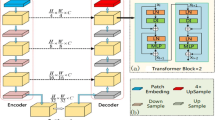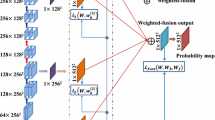Abstract
In medicine, diagnosis is as important as treatment. Retinal blood vessels are the most easily visible vessels in the whole body, and therefore, play a key role in the diagnosis of numerous diseases and eye disorders. Systematic and eye diseases cause morphologic variations, such as the growing, narrowing or branching of retinal blood vessels. Imaging-based screening of retinal blood vessels plays an important role in the identification and follow-up of eye diseases. Therefore, automatic retinal vessel segmentation can be used to diagnose and monitor those diseases. Computer-aided algorithms are required for the analysis of progression of eye diseases. This study proposes a hybrid method that provides a combination of pre-processing and data augmentation methods with a deep learning model. Pre-processing was used to solve the irregular clarification problems and to form a contrast between the background and retinal blood vessels. After pre-processing step, a convolutional neural network (CNN) was designed and then trained for the extraction of retinal blood vessels. In the training phase, data augmentation was performed to improve training performance. The CNN was trained and tested in the DRIVE database, which is commonly used in retinal blood vessel segmentation and publicly available for studies in this area. Results showed that the proposed system extracted vessels with a sensitivity of 77.78%, specificity of 97,84%, precision of 84.17% and accuracy of 95.27%.
This study also compared the results to those of previous studies. The comparison showed that the proposed method is an efficient and successful method for extracting retinal blood vessels. Moreover, the pre-processing phases improved the system performance. We believe that the proposed method and results will make contribution to the literature.











Similar content being viewed by others
References
Bengio, Y (2009). Learning deep architectures for AI technical report 1312, Dept. IRO, Universit’e de Montr’eal, Montreal, Canada, 2: 1–127.
Chen Y, Wang J, Chen X, Zhu M, Yang K, Wang Z, Xia R (2019) Single-image super-resolution algorithm based on structural self-similarity and deformation block features. IEEE Access 7:58791–58801
Chen, Y, Wang, J, Liu, S, Chen, X, Xiong, J, Yang, K (2019). Multiscale fast correlation filtering tracking algorithm based on a feature fusion model. Concurrency Computat Pract Exper https://doi.org/10.1002/cpe.5533
Chen Y, Wang J, Xia R, Zhang Q, Cao Z, Yang K (2019) The visual object tracking algorithm research based on adaptive combination kernel. J Ambient Intell Human Comput 10:4855–4867
David R (2014). Bull, chapter 4 - digital picture formats and representations, editor(s): David R. Bull, Communicating Pictures, Academic Press, 99–132.
Delibasis KK, Kechriniotis AI, Tsonos C, Assimakis N (2010) Automatic model-based tracing algorithm for vessel segmentation and diameter estimation. Comput Methods Prog Biomed 100:108–122
Dodge, S, Karam, L, (2016). Understanding how image quality affects deep neural networks. Eighth international conference on quality of multimedia experience (QoMEX), pp. 1–6.
Fan D, Cheng M, Liu Y, Li T, Borji A (2017) Structure-measure: a new way to evaluate foreground maps, IEEE international conference on computer vision (ICCV). Venice 2017:4558–4567
Fan, DP, Gong, C, Cao, Y, Ren, B, Cheng, MM, Borji, A, (2018). Enhanced-alignment measure for binary foreground map evaluation. Proceedings of the 27th international joint conference on artificial intelligence, 698-704.
Fang, B, Hsu, W and Lee, MU (2003). On the detection of retinal vessels in fundus images. http://hdl.handle.net/1721.1/3675 (10.04.2019).
Fathi A, Naghsh-Nilchi AR (2012) Automatic wavelet-based retinal blood vessels segmentation and vessel diameter estimation. Biomedical Signal Processing and Control 8:71–80
Fraz MM, Barman SA, Remagnino P, Hoppe A, Basit A, Uyyanonvara B, Rudnicka AR, Owen CG (2012) An approach to localize the retinal blood vessels using bit Planes and centerline detection. Comput Methods Prog Biomed 108:600–616
Fu K, Zhao Q, Gu IYH, Yang J (2019) Deepside: a general deep framework for salient object detection. Neurocomputing 356:69–82
Ghoshal R, Saha A, Das S (2019) An improved vessel extraction scheme from retinal fundus images. Multimed Tools Appl 78:25221–25239
Glorot, X and Bengio, Y (2010). Understanding the difficulty of training deep feedforward neural networks. Proceedings of the thirteenth international conference on artificial intelligence and statistics, Universite de Montr ´ eal, Canada, 249–256.
Goodfellow IJ, Bengio Y, Courville A (2017) Deep learning. MIT Press, USA
Guo Y, Budak Ü, Vespa LJ, Khorasani E, Şengür A (2018) A retinal vessel detection approach using convolution neural network with reinforcement sample learning strategy. Measurement 125:586–591
He, K, Zhang, X, Ren, S, Sun, J (2015). Delving deep into rectifiers: surpassing human-level performance on ImageNet classification, IEEE international conference on computer vision (ICCV), USA, December 07–13, 1026–1034.
Hemanth, DJ, Deperlioglu, O, Kose, U (2018). An enhanced diabetic retinopathy detection and classification approach using deep convolutional neural network. Neural Computing and Applications,1–15.
Hoover A, Kouznetsova V, Goldbaum M (2000) Locating blood vessels in retinal images by piece-wise Threhsold probing of a matched filter response. IEEE Trans Med Imaging 19(3):203–210
Kolar, R, Odstrcilik, J, Jan, J, Harabis, V (2011). Illumination correction and contrast equalization in colour fundus images. 19th European signal processing conference, Brno University of Technology, Barcelona, Spain, September 2, 298–302.
Kumar M, Rana A (2016) Image enhancement using contrast limited adaptive histogram equalization and wiener filter. International Journal Of Engineering And Computer Science 5:16977–16979
Lecun Y, Bottou L, Bengio Y, Haffner P (1998) Gradient-based learning applied to document recognition. Proceedings of the IEEE 86:2278–2324
Leopold HA, Orchard J, Zelek JS, Lakshminarayanan V (2019) Pixelbnn: augmenting the pixelcnn with batch normalization and the presentation of a fast architecture for retinal vessel segmentation. J Imaging 2019(5):26
Liskowski P, Krawiec K (2016) Segmenting retinal blood vessels with newline deep neural networks. IEEE Trans Med Imaging 35:2369–2380
Margolin R, Zelnik-Manor L, Tal A (2014) How to evaluate foreground maps. IEEE Conference on Computer Vision and Pattern Recognition, Columbus, pp 248–255
Marin D, Aquino A, Gegúndez-Arias ME, Bravo JM (2011) A new supervised method for blood vessel segmentation in retinal images by using gray-level and moment invariants-based features. IEEE Trans Med Imaging 30:146–158
Melinscak, M, Prentasic, P, Loncaric S (2015). Retinal vessel segmentation using deep neural networks. VISAPP 2015- 10th international conference on computer vision theory and applications, Berlin, Germany,1: 577-582.
Mendonca AM, ve Campilho A (2006) Segmentation of retinal blood vessels by combining the detection of centerlines and morphological reconstruction. IEEE Trans Med Imaging 25:1200–1213
Moccia S, Momi E, Hadji S, Mattos L (2018) Blood vessel segmentation algorithms – review of methods, data sets and evaluation metrics. Comput Methods Prog Biomed 158:71–91
Nguyen UT, Bhuiyan A, Park LA, Ramamohanarao K (2013) An effective retinal blood vessel segmentation method using multi-scale line detection. Pattern Recogn 46:703–715
Niemeijer, M, Staal, JJ, van Ginneken, B, Loog, M, Abramoff, MD, (2004). Comparative study of retinal vessel segmentation methods on a new publicly available database, in: SPIE Medical Imaging, Editor(s): J Michael Fitzpatrick, M Sonka, SPIE, vol. 5370, pp. 648–656.
Ricci E, Perfetti R (2007) Retinal blood vessel segmentation using line operators and support vector classification. IEEE Trans Med Imaging 26:1357–1365
Salem SA, Salem NM, Nandi AK (2007) Segmentation of retinal blood vessels using a novel clustering algorithm with a partial supervision strategy. Medical & Biological Engineering & Computing 45:261–273
Sane P and Agrawal R (2017). Pixel normalization from numeric data as input to neural networks for machine learning and image processing. IEEE WiSPNET conference, 2250–2254.
Soares JV, Leandro JJ, Cesar RM, Jelinek HF, Cree MJ (2006) Retinal vessel segmentation using the 2-D Gabor wavelet and supervised classification. IEEE Transaction of Medical Imaging 25:1214–1222
Soomro TA, Gao J, Khan TM, Hani AFM, Khan AUM, Manoranjan P (2017) Computerised approaches for the detection of diabetic retinopathy using retinal fundus images. Journal of Pattern Analysis and Application 20:927–961
Soomro, TA, Gao, J, Khan, MAU, Khan, TM, Paul, MA (2016). Role of image contrast enhancement technique for ophthalmologist as diagnostic tool for diabetic retinopathy. International conference on digital image computing: techniques and applications, Queensland, Australia.1- 8.
Staal JJ, Abramoff MD, Niemeijer M, Viergever MA, van Ginneken B (2004) Ridge based vessel segmentation in color images of the retina. IEEE Transactions on Medical Imaging 23:501–509
Sussman EJ, Tsiaras WG, Soper KA (1982) Diagnosis of diabetic eye disease. J Am Med Assoc 247:3231–3234
Wang C, Zhao Z, Ren Q, Xu Y, Yu Y (2019) Dense U-net based on patch-based learning for retinal vessel segmentation. Entropy 21(2):168
Wasan B, Cerutti A, Ford S, Marsh R (1995) Vascular network changes in the retina with age and hypertension. J Hypertens 13:1724–1728
Wong RKTY, Klein BEK, Tielsch JM, Hubbard L, Nieto FJ (2001) Retinal microvascular abnormalities and their Reletionship with hypertension, cardiovascular disease, and mortality. Surv Ophthalmol 46:59–80
Yao, Z, Zhang, Z, Xu, LQ, (2016). Convolutional neural network for retinal blood vessel segmentation. In proceedings of the 9th international symposium on computational intelligence and design (ISCID), Hangzhou, China, 10–11 December 2016; pp. 406–409.
Yavuz, Z., (2018). Extraction of blood vessels with pixel based classification methods in retinal fundus images, Phd Thesis, Karadeniz Technical University, Institute of Science and Technology.
Yim, J, Sohn, KA, (2017). Enhancing the performance of convolutional neural networks on quality degraded data sets. arXiv:1710.06805.
You X, Peng Q, Yuan Y, Cheung Y, Lei J (2011) Segmentation of retinal blood vessels using the radial projection and semi-supervised approach. Pattern Recogn 44:2314–2324
Zhang B, Zhang L, Zhang L, Karray A (2010) Retinal vessel extraction by matched filter with first -order derivative of gaussian. Computersin Biologyand Medicine 40:438–445
Zhao JX, Liu JJ, Fan DP, Cao Y, Yang J, Cheng MM (2019) EGNet: edge guidance network for salient object detection. In: International conference on computer vision (ICCV), pp 8779–8788
Author information
Authors and Affiliations
Corresponding author
Ethics declarations
Conflict of interest
The authors declare no conflict of interest.
Additional information
Publisher’s note
Springer Nature remains neutral with regard to jurisdictional claims in published maps and institutional affiliations.
Rights and permissions
About this article
Cite this article
Uysal, E., Güraksin, G.E. Computer-aided retinal vessel segmentation in retinal images: convolutional neural networks. Multimed Tools Appl 80, 3505–3528 (2021). https://doi.org/10.1007/s11042-020-09372-w
Received:
Revised:
Accepted:
Published:
Issue Date:
DOI: https://doi.org/10.1007/s11042-020-09372-w




